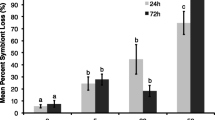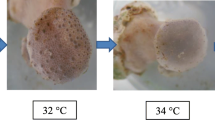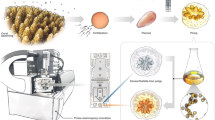Abstract
Coral reefs are in global decline, with seaweeds increasing as corals decrease. Although seaweeds inhibit coral growth, recruitment, and survivorship, the mechanism of these interactions is poorly understood. Here, we used field experiments to show that contact with four common seaweeds induces bleaching on natural colonies of Porites rus. Controls in contact with inert, plastic mimics of seaweeds did not bleach, suggesting seaweed effects resulted from allelopathy rather than shading, abrasion, or physical contact. Bioassay-guided fractionation of the hydrophobic extract from the red alga Phacelocarpus neurymenioides revealed a previously characterized antibacterial metabolite, neurymenolide A, as the main allelopathic agent. For allelopathy of lipid-soluble metabolites to be effective, the compounds would need to be deployed on algal surfaces where they could transfer to corals on contact. We used desorption electrospray ionization mass spectrometry (DESI-MS) to visualize and quantify neurymenolide A on the surface of P. neurymenioides, and we found the molecule on all surfaces analyzed, with highest concentrations on basal portions of blades.





Similar content being viewed by others
References
Aronson, R. B. and Precht, W. F. 2001. White-band disease and the changing face of Caribbean coral reefs. Hydrobiologia 460:25–38.
Barott, K. L., Rodriguez-Brito, B., Janouskovec, K., Marhaver, J. L., Smith, J. E., Keeling, P., and Rohwer, F. L. 2011. Microbial diversity associated with four functional groups of benthic reef algae and the reef building coral Montastrea annularis. Environ. Microbiol. 13:1192–1204.
Bellwood, D. R., Hoey, A. S., and Choat, J. H. 2003. Limited functional redundancy in high diversity systems: resilience and ecosystem function on coral reefs. Ecol. Lett. 6:281–285.
Bellwood, D. R., Hughes, T. P., Falke, C., and Nystrom, M. 2004. Confronting the coral reef crisis. Nature 429:827–833.
Bellwood, D. R., Hughes, T. P., and Hoey, A. S. 2006. Sleeping functional group drives coral-reef recovery. Curr. Biol. 16:2434–2439.
Birrell, C. L., Mccook, L. J., Willis, B. L., and Harrington, L. 2008a. Chemical effects of macroalgae on larval settlement of the broadcast spawning coral Acropora millepora. Mar. Ecol. Prog. Ser. 362:129–137.
Birrell, C. L., Mccook, L. J., Willis, B. L., and Diaz-Pulido, G. A. 2008b. Effects of benthic algae on the replenishment of corals and the implications for the resilience of coral reefs. Oceanogr. Mar. Biol. Annu. Rev. 46:25–64.
Box, S. J. and Mumby, P. J. 2007. Effect of macroalgal competition on growth and survival of juvenile Caribbean corals. Mar. Ecol. Prog. Ser. 342:139–149.
Brock, E., Nylund, G. M., and Pavia, H. 2007. Chemical inhibition of barnacle larval settlement by the brown alga Fucus vesiculosa. Mar. Ecol. Prog. Ser. 337:165–174.
Burkepile, D. E. and Hay, M. E. 2006. Herbivore vs. nutrient control of marine primary producers: context-dependent effects. Ecology 87:3128–3139.
Burkepile, D. E. and Hay, M. E. 2008. Herbivore species richness and feeding complementarity affect community structure and function on a coral reef. Proc. Natl. Acad. Sci. U.S.A 105:16201–16206.
Burkepile, D. E. and Hay, M. E. 2009. Nutrient versus herbivore control of macroalgal community development and coral growth on a Caribbean reef. Mar. Ecol. Prog. Ser. 389:71–84.
De Nys, R., Dworjanyn, S. A., and Steinberg, P. D. 1998. A new method for determining surface concentrations of marine natural products on seaweeds. Mar. Ecol. Prog. Ser. 162:79–87.
Dobretsov, S., Dahms, H. U., Harder, T., and Qian, P. Y. 2006. Allelochemical defense against epibiosis in Caulerpa recemosa var turbinate. Mar. Ecol. Prog. Ser. 318:165–175.
Engel, S., Jensen, P. R., and Fenical, W. 2002. Chemical ecology of marine microbial defense. J. Chem. Ecol. 28:1971–1985.
Esquenazi, E., Coates, C., Simmons, L., Gonzalez, D., Gerwick, W. H., and Dorrestein, P. C. 2008. Visualizing the spatial distribution of secondary metabolites produced by marine cyanobacteria and sponges via MALDI-TOF imaging. Mol. Biosys 4:562–570.
Esquenazi, E., Dorrestein, P. C., and Gerwick, W. H. 2009. Probing marine natural product defenses with DESI-imaging mass spectrometry. Pro. Natl. Acad. Sci. U.S.A 106:7269–7270.
Gardner, T. A., Cote, I. M., Gill, J. A., Grant, A., and Watkinson, A. R. 2003. Long-term region-wide declines in Caribbean corals. Science 301:958–60.
Hay, M. E. 2009. Marine chemical ecology: Chemical signals and cues structure marine populations, communities, and ecosystems. Annu. Rev. Mar. Sci. 1:193–212.
Hay, M. E. and Fenical, W. 1988. Marine plant-herbivore interactions: The ecology of chemical defense. Annu. Rev. Ecol. Sys. 19:111–145.
Hoegh-Guldberg, O., Mumby, P. J., Hooten, R. J., Steneck, O. S., Greenfield, P., Gomez, E., et al. 2007. Coral reefs under rapid climate change and ocean acidification. Science 318:1737–1742.
Hoey, A. S. and Bellwood, D. R. 2009. Limited functional redundancy in a high diversity system: Single species dominates key ecological process on coral reefs. Ecosystems 12:1316–1328.
Hughes, T. P. 1994. Catastophies, phase-shifts, and large-scale degradation of a Caribbean coral-reef. Science 265:1547–1551.
Hughes, T. P., Rodrigues, M. J., Bellwood, D. R., Ceccarelli, D., Hoegh-Guldberg, O., Mccook, L., et al. 2007. Phase shifts, herbivory, and the resilience of coral reefs to climate change. Curr Biol 17:360–365.
Hughes, T. P., Graham, N. A. J., Jackson, J. B. C., Mumby, P. J., and Steneck, R. S. 2010. Rising to the challenge of sustaining coral reef resilience. Trends Ecol. Evol. 25:633–642.
Ifa, D. R., Srimany, A., Eberlin, L. S., Naik, H. R., Bhat, V., Cooks, R. G., and Pradeep, T. 2011. Tissue imprint imaging by desorption electrospray ionization mass spectrometry. Anal. Methods 3:1910–1912.
Jackson, J. B. C., Kirby, M. X., Berger, W. H., Bjorndal, K. A., Botsford, L. W., Bourque, B. J., et al. 2001. Historical overfishing and the recent collapse of coastal ecosystems. Science 293:629–638.
Jompa, J. and Mccook, L. J. 2003. Coral-algal competition: macroalgae with different properties have different effects on corals. Mar. Ecol. Prog. Ser. 258:87–95.
Kubanek, J., Whalen, K. E., Engel, S., Kelly, S. R., Henkel, T. P., Fenical, W., and Pawlik, J. R. 2002. Multiple defensive roles for triterpene glycosides from two Caribbean sponges. Oecologia 131:125–136.
Kubanek, J., Jensen, P. R., Keirfer, P. A., Sullards, M. C., Collins, D. O., and Fenical, W. 2003. Seaweed resistance to microbial attack: A targeted chemical defense against marine fungi. Proc. Natl. Acad. Sci. U.S.A 100:6916–2921.
Kubanek, J., Prusak, A. C., Snell, T. W., Giese, R. A., Fairchild, C. R., Aalbersbeg, W., and Hay, M. E. 2006. Bromophycolides C-I from the Fijian red algae Callophycus densus. J. Nat. Prod. 69:731–735.
Kubanek, J., Prusak, A. C., Snell, T. W., Giese, R. A., Hardcastle, K. I., Fairchild, C. R., Aalbersberg, W., Raventos-Suarez, C., and Hay, M. E. 2005. Antineoplastic diterpene-benzoate macrolides from the Fijian red alga Callophycus serratus. Org. Lett. 7:5261–5264.
Lane, A. L., Stout, E. P., Hay, M. E., Prusak, A. C., Hardcastle, K., Fairchild, C. R., et al. 2007. Callophycoic acids and callophycols from the Fijian red alga Callophycus densus. J. Org. Chem. 72:7343–7351.
Lane, A. L., Nyadong, L., Gahlena, A. S., Shearer, T. L., Stout, E. P., Parry, R. M., et al. 2009. Desorption electrospray ionization mass spectrometry reveals surface-mediated antifungal chemical defense of a tropical seaweed. Pro. Natl. Acad. Sci. U.S.A 106:7314–7319.
Ledlie, M. H., Graham, N. A. J., Bythell, J. C., Wilson, S. K., Jennings, S., Polunin, N. V. C., and Hardcastle, H. 2007. Phase shifts and the role of herbivory in the resilience of coral reefs. Coral Reefs 26:641.
Leichter, J. J., Stewart, H. L., and Miller, S. L. 2003. Episodic nutrient transport to Florida coral reefs. Limnol. Oceano. 48:1394–1407.
Lewis, S. M. 1986. The role of herbivorous fishes in the organization of a Caribbean reef community. Ecol. Monographs 56:183–200.
Mcmanus, J. W. and Polsenberg, J. F. 2004. Coral-algal phase shifts on coral reefs: ecological and environmental aspects. Prog. Oceano. 60:263–279.
Mumby, P. J. 2009. Phase shifts and the stability of macroalgal communities on Caribbean coral reefs. Coral Reefs 28:761–773.
Mumby, P. J. and Steneck, R. S. 2008. Coral reef management and conservation in light of rapidly evolving ecological paradigms. Trends Ecol. Evol. 23:555–63.
Nugues, M. M., Smith, G. W., Hooidonk, R. J., Seabra, M. I., and Bak, R. P. M. 2004. Algal contact as a trigger for coral disease. Ecol. Letters 7:919–923.
Nyadong, L., Hohenstein, E. G., Gahlena, A., Lane, A. L., Kubanek, J., Sherrill, C. D., and Fernandez, F. M. 2009. Reactive desorption electrospray ionization mass spectrometry (DESI-MS) of natural products of marine alga. Anal. Bioanal. Chem. 394:245–254.
Nylund, G. M., Cervin, G., Hermansson, M., and Pavia, H. 2005. Chemical inhibition of bacterial colonization by Bonnemaisonia hamifera. Mar. Ecol. Prog. Ser. 302:27–36.
Nylund, G. M., Persson, F., Lindergarth, M., Cervin, G., Hermansson, M., and Pavia, H. 2010. The red alga Bonnemaisonia asparagoides regulates epiphytic bacterial abundance and community composition by chemical defence. FEMS Mico. Ecol. 71:84–93.
Ostrander, G. K., Armstrong, K. M., Knobbe, E. T., Gerace, D., and Skully, E. P. 2000. Rapid transition in the structure of a coral reef community: The effects of coral bleaching and physical disturbance. Proc. Natl. Acad. Sci. U.S.A 97:5297–5302.
Paul, V. J., Kuffner, I. B., Walters, L. J., Ritson-Williams, R., Beach, K. S., and Becerro, M. A. 2011. Chemically mediated interactions between macroalgae Dictyota spp. and multiple life history stages of the coral Porites asteroids. Mar. Ecol. Prog. Ser. 426:161–170.
Rasher, D. B. and Hay, M. E. 2010. Chemically-rich seaweeds poison corals when not controlled by herbivores. Proc. Natl. Acad. Sci. U. S. A 107:9683–9688.
Rasher, D. B., Stout, E. P., Engel, S., Kubanek, J., and Hay, M. E. 2011. Macroalgal terpenes function as allelopathic agents against reef corals. Proc. Natl. Acad. Sci. U.S.A 108:17726–17731.
Ritchie, K. B. 2006. Regulation of microbial populations by coral surface mucus and mucus-associated bacteria. Mar. Ecol. Prog. Ser. 322:1–14.
Rogers, C. S. and Miller, J. 2006. Permanent ‘phase shifts’ or reversible decline in coral cover? Lack of recovery of two coral reefs in St. John, US Virgin Islands. Mar. Ecol. Prog. Ser. 306:103–114.
Schmitt, T. M., Hay, M. E., and Lindquist, N. 1995. Constraints on chemically mediated coevolution: multiple functions for seaweed secondary metabolites. Ecology 76:107–123.
Smith, J. E., Shaw, M., Edwards, R. A., Obura, D., Pantos, O., Sala, E., et al. 2006. Indirect effects of algae on coral: algae-mediated, microbe-induced coral mortality. Ecol. Letters 9:835–845.
Steinberg, P. D. and De Nys, R. 2002. Chemical mediation of colonization of seaweed surfaces. J. Phycol. 38:621–629.
Steinberg, P. D., Schneider, R., and Kjelleberg, S. 1997. Chemical defenses of seaweeds against microbial colonization. Biodegradation 8:211–220.
Stout, E. P., Hasemeyer, A. P., Lane, A. L., Davenport, T. M., Engel, S., Hay, M. E., et al. 2009. Antibacterial neurymenolides from the Fijian red alga Neurymenia fraxinifolia. Org. Letters 11:225–228.
Takats, Z., Wiseman, J. M., Gologan, B., and Cooks, R. G. 2004. Mass spectrometry sampling under ambient conditions with desorption electrospray ionization. Science 306:471–473.
Acknowledgments
We thank the Fijian government and the Korolevu-i-wai district elders for granting research permissions, C. Dell, A. Warneke, D. Gibbs, and A. Hoey for field help, and V. Bonito for scientific and cultural insight in Fiji. Support came from the National Science Foundation (OCE 0929119), the National Institutes of Health (U01-TW007401), and the Teasley Endowment to the Georgia Institute of Technology. FMF acknowledges support from ARRA NSF MRI Instrument Development grant #0923179.
Author information
Authors and Affiliations
Corresponding author
Electronic Supplementary Material
Below is the link to the electronic supplementary material.
ESM 1
(DOCX 193 kb)
Rights and permissions
About this article
Cite this article
Andras, T.D., Alexander, T.S., Gahlena, A. et al. Seaweed Allelopathy Against Coral: Surface Distribution of a Seaweed Secondary Metabolite by Imaging Mass Spectrometry. J Chem Ecol 38, 1203–1214 (2012). https://doi.org/10.1007/s10886-012-0204-9
Received:
Revised:
Accepted:
Published:
Issue Date:
DOI: https://doi.org/10.1007/s10886-012-0204-9




